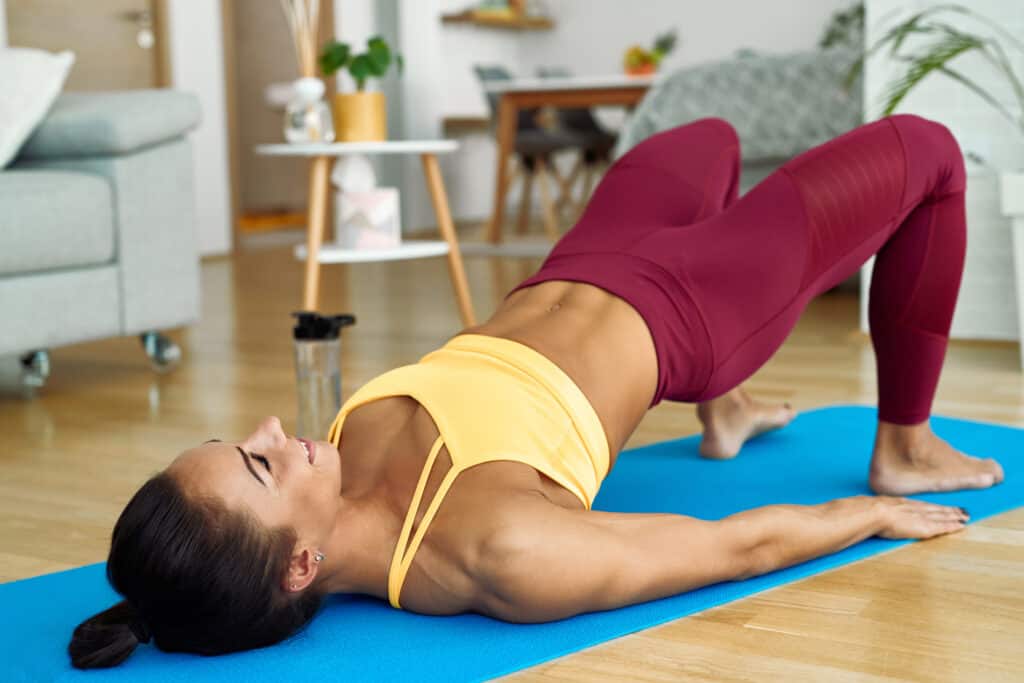In a perfect world, the human pelvis has a slight, forward tilt, of a few degrees when standing. We know good posture is important for many reason. Try this simple test to check the status of your own posture. First, stand up against a wall. Touch both of your heels to the wall. Then, moving up the body, try to touch the calves, buttock, back and head, all against the wall. Next, tuck the chin slightly and gently pull the navel in towards the spine. Now walk away from the wall, maintaining this tall, engaged posture. This is considered optimal standing posture.
From a side profile, you should see the ankle lined up with the knee. The knee should line up with the middle of the hip and right up through the middle shoulder and ear. Problems can arise, however, when the pelvis is not positioned in a neutral position. When rotated excessively, either forward or backward, (and maintained for long periods of time), back issues can occur.
Anterior Pelvic Tilt
When the pelvis rotates forward more than 6-7 degrees, an anterior pelvic tilt occurs. When the pelvis moves backward away from a neutral position, a posterior pelvic tilt occurs. A anterior pelvic tilt typically occurs as a result of weak and tight muscles. More specifically, the abdominal and glute muscles are weak while the hip flexors and erector spinae are tight. Sounds like a little foam rolling, a good warm-up and a few strength exercises are needed?
Anterior Pelvic Tilt: Short Program
- Use a foam roller to roll-out tight hip flexors and upper & lower back. Perform a scorpion exercise to stretch the low back.
- Improve hip and back mobility (a good Yin Yoga class would help here).
- Perform the following stretch and exercises in order to increase core and glute strength. Our suggestions: glute bridge and plank with hip abduction.
Posterior Pelvic Tilt: Short Program
There are several factors that cause the pelvis to rotate posteriorly. Most common of which stem from chronic postural misuse such as long periods of sitting, especially in a slouched position.
In addition, there are several muscular factors that may contribute to the posterior pelvic tilt. Tightness in the abdominal muscles and/or tightness in the hamstrings may pull the pelvis posteriorly. In terms of best corrective exercises for posterior tilt issues, try various forms of lunges to strengthen the posterior chain. Developing strong leg muscles can help correct a posterior tilt by preventing any one muscle from dominating. More often than not, the posterior rotation is an adapted pattern that is typically reinforced by poor mechanics when sitting and standing. An occasional massage would also be beneficial for relaxing any tight tissue around the hip area. Here are a few movements recommended by Jefit that will help.
- Stretch abdominals, obliques and hamstrings.
- Add various forms of lunges to your training routine. If you need a bodyweight exercise, try a superman exercise.
- Regular foam rolling, mobility work and adding weekly Yin Yoga sessions to your overall routine will help.
Band Hamstring Stretch 3 x 30 seconds
DB Reverse Lunge 3 x 8
Superman 2 x 30 seconds
Final Thoughts
Individuals that have either an anterior or posterior pelvic tilt need to work on fixing the issues mentioned here depending on the severity of the condition. This article addresses the issue from a high level only. See your physician, for more severe cases, who should refer you to a good physical therapist who can evaluate at it with a different lense. An occasional massage will also be very beneficial for relaxing any tight tissue around these areas.
Stay Strong Together
Try the award-winning Jefit app for your next workout. Take advantage of Jefit’s exercise database for planning & tracking your strength workouts. Named best app for 2022 and 2023 by PC Magazine, Men’s Health, The Manual, the Greatist and many others. The app comes equipped with a customizable workout planner and training log. The app also has ability to track data, offer audio cues, and has a feature to share workouts with friends. Visit our members-only Facebook group. Connect with like-minded people, share tips, and advice to help get closer to reaching your fitness goals. Try one of the new interval-based workouts and add it to your weekly training schedule.
- Why Recovery Time Between Sets Matters for Muscle Growth - July 9, 2025
- Is Added Sugar OK After a Workout? - July 7, 2025
- AMRAP Workouts: Is it Worth the Effort? - July 4, 2025
